Last Updated on December 18, 2024 by worldofteainfusers
For some time now I’ve always wanted to get my hands on a cast iron teapot. It’s something I’ve been longing to own and add to my ever growing collection of teapots and tea infusers. Originally I wanted the dragonfly cast iron teapot from Teavana but found them to be quite expensive – almost $200!
After doing some research I came across the Old Dutch Placidity Lavender Teapot on Amazon. It was a fraction of the price and at the time cost less than 20 bucks! The Old Dutch dragonfly teapot was much cheaper compared to the Teavana version for an almost identical product.
This blog post contains affiliate links which sends me a small bit of funds if you choose to use them, at no extra cost to you.
I’ll admit I originally wanted the teapot at Teavana because of the style and design. I loved the shape of the teapot and the dragonfly on it.
However when I found the Old Dutch teapot I knew I had found the one.
It had the same style and design I was looking for, but came in a prettier color (hello lavender!) and at a fraction of the price. I knew I found something unique and couldn’t wait to get my hands on it to review.
Click to view the most up to date price at Amazon.
What Is an Old Dutch Cast Iron Teapot?
The Placidity teapot by Old Dutch is a lovely Japanese style tetsubin made from cast iron.
A tetsubin is a word commonly used to describe Japanese cast iron pots. It has what we’re used to seeing in our regular household teapots: a handle, spout, and lid.
Traditionally tetsubins were heated over fire and used for boiling water and making tea. However the more westernized tetsubins produced today cannot be in direct contact with fire or stovetops. This is because modern cast iron teapots are coated with a porcelain enamel on the inside. This helps to protect against rust and oxidization. Placing the teapot within direct contact to open source heat will cause the enamel to crack.
Further below we’ll discuss how to use and care for cast iron teapots.
What It Looks Like
The Old Dutch teapot isn’t large but I was surprised at how heavy it was. Also keep in mind that once you add water to your tetsubin it will make an already heavy pot heavier.
It can hold up to 26 ounces of water which makes approximately 2 – 3 cups of tea. I find this to be a perfect amount of tea for myself, as I do not have to constantly re-brew, but it’s a small enough amount of tea that it doesn’t sit around for too long and become bitter or cold.
Color
This particular Old Dutch cast iron teapot has a lovely lavender exterior finish.
It has an embossed dragonfly that sits just below the teapots lid. When you run your fingers along the outside of the teapot, you can feel the texture that makes up the design on the pot. In some areas you can also see some of the cast iron through the paint, which gives the teapot an authentic look and feel.
Old Dutch has many cast iron teapots that come in a variety of colors and sizes.
Some of the many colors they have are:
- Light Green
- Greek Wine
- Matte Black
- Dusk
- Moss Green
- Waterfall Blue
- Red
- Plum
You can view a full list of Old Dutch’s Cast Iron Teapots.
Design
The Old Dutch cast iron tetsubin has a black porcelain enamel interior. This helps protect it from rust by not allowing water to be exposed to the cast iron.
Due to the interior coating, it’s important you remember one important rule:
Do not heat your teapot directly on top of a stove!
Doing so will cause the enamel to crack and break apart.
The cast iron teapot also comes with a large removable stainless steel tea infuser for brewing loose leaf tea.
What I like about removable tea infusers is that you can choose to place your loose leaf tea inside the infuser to brew, or place directly inside the teapot without an infuser for brewing. If the later, then you can use a tea strainer to filter your tea with afterwards.
The Old Dutch teapot has a removable lid. Like the teapot, the lid also has some weight to it. This is good because you then do not have to worry about the lid falling off when pouring tea and potentially burning yourself.
The teapots handle is also made from cast iron. This will conduct heat as you’re brewing tea so be careful not to burn yourself with the handle. Be sure to use a cloth or oven mit when holding the handle.
Speaking of handles, one of my biggest pet peeves when it comes to teapots are flimsy handles.
Not sure why but there’s something about a loose handle that easily swings around that really annoys me. It’s safe to say that the Old Dutch handle has resistance and is fairly firm, and does not easily swing from side to side.
How to Use
As mentioned earlier, improper heating techniques will cause the interior coating to crack and break apart.
Therefore never heat your cast iron teapot directly on a stovetop.
Instead you should boil water separately in a tea kettle, and then once the proper temperature has been reached, pour that water into your cast iron teapot for steeping.
Below are the steps I use when brewing tea in a cast iron teapot:
- Step 1: Remove lid and tea infuser basket
- Step 2: Preheat your teapot by pouring in a small amount of hot water. Place the lid back on and swish the water around
- Step 3: Let the water sit for a few minutes and then pour it out
- Step 4: Then place your choice of loose leaf tea inside the tea infuser basket
- Step 5: Place the tea infuser basket back inside your teapot
- Step 6: Slowly pour in hot water and fill to a maximum of one inch below the lid opening
- Step 7: Place the lid back on and steep for the appropriate amount of time
Using a teapot does not require a stove top at all. However you do need a separate kettle or pot to heat the water in before transferring it into your teapot.
When using your cast iron teapot for the very first time, be sure to thoroughly rinse and wash it out before using it to brew tea.
The Results
What I really wanted to know about the Old Dutch cast iron tetsubin was how long it kept my tea hot for, and how much room the tea infuser basket had for leaf expansion.
This would allow me to determine what types of teas were best for brewing inside my teapot.
Test #1
I decided to brew a cup of Buddha’s Blend by DAVIDsTEA, a white and green tea blend that also has jasmine pearls. I chose this type of tea because it has large leaves when it expands.
I filled the tea infuser basket with one teaspoon of loose tea, and filled the teapot with hot water. I poured just enough so that there was about an inch of space left underneath the lid opening. I placed the lid back on and waited for my tea to steep.
When it was ready I carefully removed the lid and tea infuser basket. Be careful not to use your bare hands because everything will be quite hot due to the cast iron.
When I pulled out the infuser, I noticed the leaves expanded very nicely and had a lot of room. The large infuser basket that comes with the Old Dutch cast iron teapots is a perfect size for brewing loose leaf tea. It allows a lot of room for leaf expansion, which is important for teas that have very large leaves when they unfurl. A lot green, oolong, and black teas have large leaves that are best brewed in spacious infusers. The mesh in the infuser basket was also fine enough in that there weren’t any leaves that fell through.
Test #2
Now I wanted to see how long my tea stayed hot for in a cast iron tetsubin.
For the second brew I decided to steep a cup of Blueberry Jam, a delicious black tea by DAVIDsTEA.
I wanted to use a tea that requires hotter water for steeping, so I can have a better understanding of how long tea stays hot for in a cast iron teapot. Blueberry Jam recommends heating water to about 96 degrees Celsius (204 degrees Fahrenheit).
About an hour later I came back and was pleasantly surprised to see that the tea was still hot. It wasn’t piping hot like it was earlier, but it wasn’t lukewarm either.
This is fine by me as I usually drink my tea well before it begins to cool down too much. However if you would like to keep tea hot in your cast iron teapot for longer than an hour, then I recommend using a teapot warmer. You place a tea light candle inside the warmer, and then place your cast iron teapot on top of the warmer.
In both tests I was also able to make myself about two and a half cups of tea from just one brew. I find this to be a perfect amount for myself as I usually do not drink more than two cups of the same tea at a time.
The Old Dutch cast iron teapot also pours very nicely from the spout and does not spill or make a mess.
The one small caveat I noticed was that the lid was a tiny bit loose. It didn’t have a perfect snug fit. I’m not sure if it just happened to be the teapot I had, however I found it to be a very minor issue. I have to actually push the lid with my hand for it to move, and the lid itself is heavy enough that I don’t have to worry about it falling off when pouring tea.
In terms of drinking the tea, I felt like the tea itself also had a refreshing taste. I’ve had Buddha’s Blend and Blueberry Jam many times before, but there was just something about brewing it inside a cast iron teapot that made it taste and feel more authentic. I did not notice any unusual tastes and I made sure to thoroughly clean it before as well.
Pros & Cons
I find the Old Dutch cast iron tetsubin to be a lovely tool for steeping tea. Its simplicity and authentic look makes tea time feel more traditional. It can also feel heavier than other teapots but at least you don’t have to worry about breaking it!
Pros
- Beautiful and elegant cast iron tetsubin
- Keeps tea hot for about an hour
- Able to use a teapot warmer to keep tea warmer for longer
- You get a good arm workout
Cons
- Cannot use direct heat or fire as the porcelain enamel will crack (however you are not suppose to use teapots on stove tops to begin with)
- The lid moves ever so slightly when I push it however it is heavy enough on its own that it will not fall off when pouring tea
How to Clean Your Cast Iron Teapot
I don’t think I’ve come across a teapot that’s easier to clean and care for then a cast iron teapot. All you need is warm water and a cloth.
It’s important to note that:
The first time you purchase a cast iron teapot be sure to clean it thoroughly.
To do so I’ll heat a bit of water, fill my teapot, and then let the water sit for several minutes. I then swoosh the water around and pour it out.
I repeated this process three times because I wanted to be very thorough and make sure there was no residue left inside.
Afterwards cleaning and caring for your cast iron teapot is very easy. Whenever you’re finished steeping tea, simply rinse out with warm water. I then like to take a cloth and wipe down the inside and outside as well. I do not use any dish soap and always clean by hand after each use.
- Use warm water to rinse
- Clean after each use
- Do not use harsh cleaners such as chlorine or beach based cleaners
- Do not use harsh scrubs, cleaning bristles, or metal that will scratch the enamel interior
- Not dishwasher safe
I also never place inside a dishwasher and always let it air dry afterwards.
Other Uses
You can also use your cast iron teapot as a mini dehumidifier!
Simply pour in hot water and place your teapot nearby. The steam will slowly begin to evaporate.
When I do this I like to keep the lid off and place the pot on top of a tea trivet so I don’t leave any heat marks on my table.
This is perfect in the colder months when the air becomes much drier.
Final Thoughts
I’ll admit that I didn’t know what to expect with my first cast iron teapot. However as soon as I opened the package I quickly fell in love. In my hand was a beautiful lavender teapot with dragonflies embossed on the outside.
Looks aside, it also makes a decent amount of tea for one or two people. It retains its heat for about an hour and does not spill from the spout when you pour. Did I mention earlier it’s also super easy to wash and care for?
The large stainless steel infuser basket it comes with is also a huge plus in my books. You’re able to steep a wide variety of teas because it has lots of room for leaf expansion. It’s also nice to have an infuser made with finer mesh so half your tea leaves don’t fall out.
For the price, quality, and design of the Old Dutch Placidity Lavender Teapot I’d have to say I’m very impressed.
If cast iron teapots aren’t your cup of tea, you can consider glass teapots such as the Hario Glass Teapot with Infuser.
Product Details
- Makes about 2 and a half cups of tea (26 oz / 750 mL)
- Tea retains heat for about an hour
- Removable large stainless steel tea infuser
- Porcelain enamel interior prevents rust and oxidization
- Not dishwasher safe
- Not microwave safe
The Old Dutch Placidity Lavender Teapot can be purchased at Amazon or at the Old Dutch website.
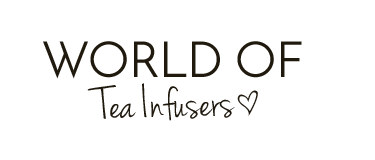
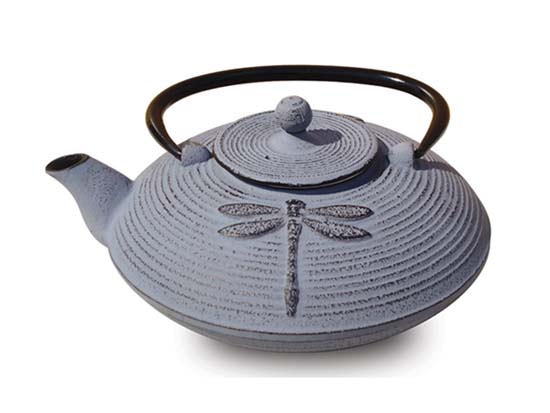
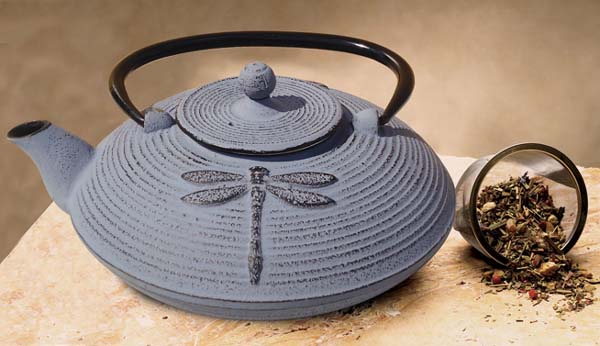
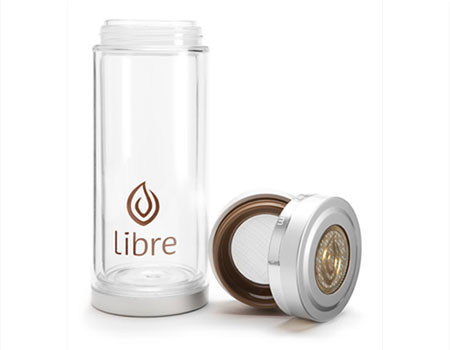
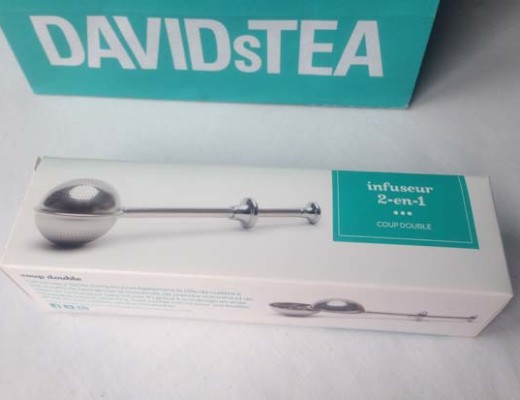
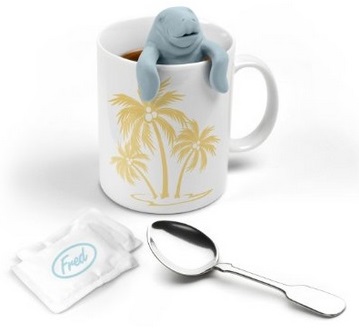
No Comments